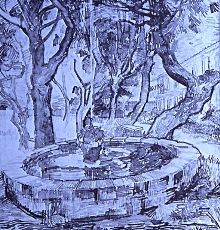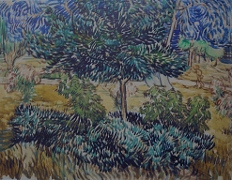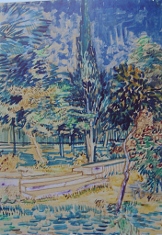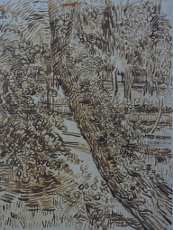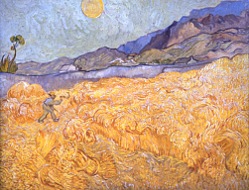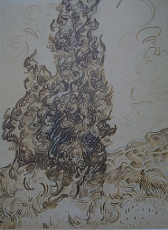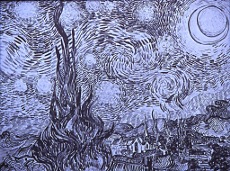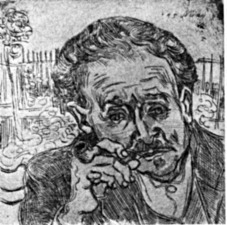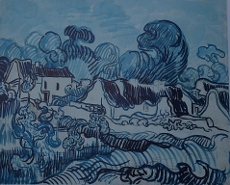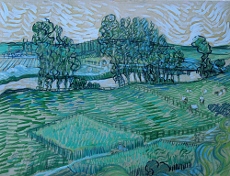Saint-Rémy-de-Provence 1889 – 1890 · 4047 dagen geleden by Ad van den Ende
To Theo van Gogh. Saint-Rémy-de-Provence, on or about Thursday, 23 May 1889.
“However, the landscape of St-Rémy is very beautiful, and little by little I’m probably going to make trips into it. But staying here as I am, the doctor has naturally been in a better position to see what was wrong, and will, I dare hope, be more reassured
and will allow me to paint.
…
Through the iron-barred window I can make out a square of wheat in an enclosure, a perspective in the manner of Van Goyen, above which in the morning I see the sun rise in its glory.”
Corridor in the clinic
The clinic had a large garden, which was a constant source of inspiration to Vincent. The first drawings Vincent made featured this garden. These drawings are among the best he did that year.
Fountain in the garden of the clinic.
There are hardly any open places. Such a composition can easily become to dense, but Vincent avoided this danger. The drawing is pure and transparant.
Trees and shrubs in the gardenof the clinic
“The same is true in a group of seven brush drawings from this period. (…) Van Gogh was not interested in creating depth in these compositions but was concentrating instead on rhythm, with swirling patterns of leaves and self-assured brushstrokes.
Steps in the garden of the clinic
The slightly abstract result almost resembles the character of a mosaic and looks extremely modern.” (Van Heugten)
Tree with ivy
From his room Vincent saw a walled wheatfield.
In July 1889 he made this painting: Wheatfield with reaper.
In Saint-Rémy Vincent gave the figure of the reaper a clear symbolic meaning, as he had done earlier with the sower. He wrote to Theo:
To Theo van Gogh. Saint-Rémy-de-Provence, Thursday, 5 and Friday, 6 September 1889.
“I’m writing you this letter bit by bit in intervals when I’m tired of painting. Work is going quite well – I’m struggling with a canvas begun a few days before my indisposition. A reaper, the study is all yellow, terribly thickly impasted, but the subject was beautiful and simple. I then saw in this reaper – a vague figure struggling like a devil in the full heat of the day to reach the end of his toil – I then saw the image of death in it, in this sense that humanity would be the wheat being reaped. So if you like it’s the opposite of that Sower I tried before. But in this death nothing sad, it takes place in broad daylight with a sun that floods everything with a light of fine gold.”
Vincent was very taken with the cypresses.
A cypress
To Theo van Gogh. Saint-Rémy-de-Provence, Tuesday, 25 June 1889.
“The cypresses still preoccupy me, I’d like to do something with them like the canvases of the sunflower because it astonishes me that no one has yet done them as I see them.
It’s beautiful as regards lines and proportions, like an Egyptian obelisk.
And the green has such a distinguished quality.
It’s the dark patch in a sun-drenched landscape, but it’s one of the most interesting dark notes, the most difficult to hit off exactly that I can imagine.
Now they must be seen here against the blue, in the blue, rather.
To do nature here, as everywhere, one must really be here for a long time.”
Vincent used a wide reed pen to give the tree ‘a decorative rhythm and the feel of a windy day’.
Starry Night
We see a steeple church tower, such as in Northern Erope. Vincent’s thoughts went to the North.
Auvers-sur-Oise 1890
In May 1890 Vincent decided to discharge himself from the clinic. He wrote to Theo that he might settle in northern France. His friend Camille Pissaro had sugested to Theo that Auvers-sur-Oise would be a good place for Vincent. Doctor Gachet was willing to keep an eye on Vincent.
Doctor Gachet
After leaving Saint-Rémy Vincent paid a visit to Theo and his family in Paris.
To Theo van Gogh and Jo van Gogh-Bonger. Auvers-sur-Oise, Tuesday, 20 May 1890.
“I really felt in Paris that all the noise there wasn’t what I need.
How pleased I am to have seen Jo and the little one and your apartment, which is indeed better than the other one.
Wishing you good luck and health, and hoping to see you again very soon, good handshakes
Vincent.”
Landscape with cottages
“… landscape with cottages is done entirely in shades of blue. The leaves, which are depicted with great subtlety, are worked in attractive, fluent brushstrokes.” (Van Heugten)
To Theo van Gogh and Jo van Gogh-Bonger. Auvers-sur-Oise, on or about Wednesday, 21 May 1890.
“Auvers is decidedly very beautiful. So much so that I think it’ll be more advantageous to work than not to work, despite all the bad luck that’s to be foreseen with painting.
It’s very colourful here – but what pretty middle-class country houses there are; much prettier than Ville-d’Avray, to my taste. (…)
My dear fellow, upon reflection I don’t say that my work is good, but it’s the least bad that I can do. All the rest, relations with people, is very secondary, because I have no talent for that.”
“Here we’re far enough from Paris for it to be the real countryside, but nevertheless, how changed since Daubigny. But not changed in an unpleasant way, there are many villas and various modern and middle-class dwellings, very jolly, sunny and covered with flowers. This in an almost lush countryside, just at this moment of the development of a new society in the old one, has nothing disagreeable about it; there’s a lot of well-being in the air. I see or think I see a calm there à la Puvis de Chavannes, no factories, but beautiful greenery in abundance and in good order.”
Landscape with a bridge over the Oise
“… this sketchy study in pencil – which Van Goch, which real feeling for rhytm and simplicity, worked up in watercolour, oil paint (in the sky and other places) and pen en ink (in such details as the cows and the figures with the wheelbarrow) – most probably originated in the first weeks after his arrival.” Teio Meedendorp
Vincent was pessimistic about the future.
“On Sunday 27 July 1890 Van Gogh shot himself in the chest. Two days later, at the age of thirty-seven, he died with his brother on his side. The personal esteem in which he was held and his growing reputation as an artist were clearly expressed at his funeral, and among the condolescences offered to Theo, the most striking were the simple words of Eugène Boch: ‘A great artist is dead.‘” (Van Heugten)
On 25 July 1890 Theo had written to Jo, his wife:
“His letter included a couple of sketches of paintings he’s working on, which look very nice. If only he could find someone to buy a couple from him, but I’m afraid this could still take a very long time. But one cannot drop him when he’s working so hard and so well. When will a happy time come for him? He’s so thoroughly good and helped me so much to keep going.”
In his last – unfinished- letter to Theo Vincent writes: “Ah well, I risk my life for my own work and my reason has half floundered in it – very well- but you’re not one of the dealers in men; as far as I know and can judge I think you really act with humanity; but what can you do “ The last sentence is unfinished.
“We will never know why Van Gogh took his own life, but these last letters hint that a combination of factors – a sense of being a burden, the difficulties of the art market, fear of recurring illness, loneliness and despair – may have led him to it.” Ann Dumas



